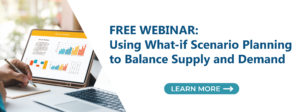Every supply chain organization has established plans for their supply chains to meet expectations. These plans help keep the supply chain running smoothly, like guiding a ball to the finish line. However, unexpected obstacles emerge routinely.
Some of these obstacles are minor, while others loom large. Some are foreseeable from a distance, while others materialize suddenly. To thrive, all supply chains must possess the capacity to anticipate, perceive, and respond to these unforeseen challenges.
Supply chain planning has evolved beyond being a monthly routine. Less inventory and quick market changes make it important for demand and supply planners to stay alert all month.
They should regularly assess their performance against the plan and stay informed about any market changes that may necessitate swift adjustments. This necessitates planners to assess various potential scenarios, allowing the business to be well-prepared for different outcomes if events unfold in a particular manner.
During COVID years, several disruptive events posed threats to all supply chains. Most companies struggled; yet some successful ones were better equipped to navigate this turbulent environment. Leading supply chains didn’t merely stand idly by amid chaos and disruption; they swiftly rose to the occasion and some even leapfrogged the competition. They demonstrated the ability to swiftly adapt processes, systems, networks, and cultures — they not only prioritized efficiency but also resilience and agility. An essential tool in achieving this transformation was scenario planning.
In the context of the current situation in the supply chains, scenario planning can be likened to the one available way out. It provides a framework and a set of tools to help us pinpoint risks and opportunities, outline various “what if” scenarios, offer recommendations, and enable organizations to make faster, more precise, better aligned, and more collaborative decisions.
While the general awareness of scenario planning has gone up, one is by no means excelling at it. According to a survey conducted by Gartner in 2022. And in more than 50% of the cases, the adverse effects could not be avoided. In other words, one keeps running into the obstacles and coming to a halt or at least slowing down considerably. This is exactly what scenario planning is supposed to help avoid. And when one reacts to such an adverse effect, the business impact is significant. One must quickly divert resources from managing the daily operation to managing and containing the adverse event du jour, which can lead to greater organizational impact, and reduced resilience. According to Gartner, failing to avoid such adverse effects can destroy up to 68% of corporate value. That is very significant.
If companies understand that scenario planning is important and try to do scenario planning, why do they fail? The reason might be that it is not very straightforward. How to pick the important ones, how to model, how to evaluate, and how to connect to the final decisions.
View our on-demand webinar and learn how to use “what-if” scenario planning to balance supply and demand.






